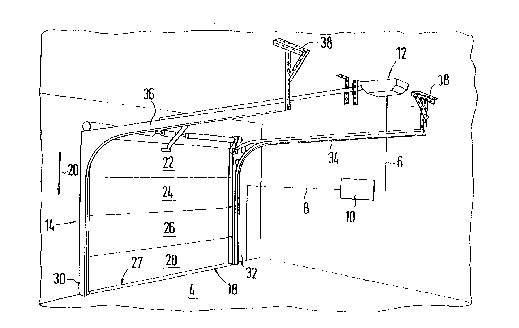Some of the information on this Web page has been provided by external sources. The Government of Canada is not responsible for the accuracy, reliability or currency of the information supplied by external sources. Users wishing to rely upon this information should consult directly with the source of the information. Content provided by external sources is not subject to official languages, privacy and accessibility requirements.
Any discrepancies in the text and image of the Claims and Abstract are due to differing posting times. Text of the Claims and Abstract are posted:
| (12) Patent Application: | (11) CA 2110035 |
|---|---|
| (54) English Title: | SAFETY SYSTEM FOR PASSAGE CLOSURE MEMBERS |
| (54) French Title: | SYSTEME DE SECURITE POUR ELEMENTS DE FERMETURE DE VOIES D'ACCES |
| Status: | Deemed Abandoned and Beyond the Period of Reinstatement - Pending Response to Notice of Disregarded Communication |
| (51) International Patent Classification (IPC): |
|
|---|---|
| (72) Inventors : |
|
| (73) Owners : |
|
| (71) Applicants : | |
| (74) Agent: | SWABEY OGILVY RENAULT |
| (74) Associate agent: | |
| (45) Issued: | |
| (86) PCT Filing Date: | 1992-05-23 |
| (87) Open to Public Inspection: | 1992-12-10 |
| Availability of licence: | N/A |
| Dedicated to the Public: | N/A |
| (25) Language of filing: | English |
| Patent Cooperation Treaty (PCT): | Yes |
|---|---|
| (86) PCT Filing Number: | PCT/EP1992/001164 |
| (87) International Publication Number: | EP1992001164 |
| (85) National Entry: | 1993-11-25 |
| (30) Application Priority Data: | ||||||
|---|---|---|---|---|---|---|
|
ABSTRACT
A safety system for a passage closure
member, such as a gate, door, window, sliding roof
or the like, has a drive whose maximal admissible
strain value is adjustable and a control device by
means of which the drive can be switched off. When
the drive is switched off because the maximal
admissible strain value has been attained, a signal
S2 at the moment in time T2 is transmitted to the
control device. In the area of the pressing and/or
closing edge of the closure member is arranged a
sensor that transmits a signal S1 at the moment in
time T1 when an obstacle occurs. The control device
calculates, when the maximal admissible strain value
is attained, the differential value between
the moments in time .DELTA. Treal = T2-T1. The control
device compares the value .DELTA. Treal with a
predetermined value Tprede., and when .DELTA. Treal is higher
than .DELTA. Tpredet., the direction of movement of the
closure member is changed.
Note: Claims are shown in the official language in which they were submitted.
Note: Descriptions are shown in the official language in which they were submitted.

2024-08-01:As part of the Next Generation Patents (NGP) transition, the Canadian Patents Database (CPD) now contains a more detailed Event History, which replicates the Event Log of our new back-office solution.
Please note that "Inactive:" events refers to events no longer in use in our new back-office solution.
For a clearer understanding of the status of the application/patent presented on this page, the site Disclaimer , as well as the definitions for Patent , Event History , Maintenance Fee and Payment History should be consulted.
| Description | Date |
|---|---|
| Inactive: IPC deactivated | 2016-03-12 |
| Inactive: IPC assigned | 2016-02-10 |
| Inactive: First IPC assigned | 2016-02-10 |
| Inactive: IPC assigned | 2016-02-10 |
| Inactive: IPC expired | 2015-01-01 |
| Application Not Reinstated by Deadline | 2000-05-23 |
| Time Limit for Reversal Expired | 2000-05-23 |
| Inactive: Abandon-RFE+Late fee unpaid-Correspondence sent | 1999-05-25 |
| Deemed Abandoned - Failure to Respond to Maintenance Fee Notice | 1999-05-25 |
| Application Published (Open to Public Inspection) | 1992-12-10 |
| Abandonment Date | Reason | Reinstatement Date |
|---|---|---|
| 1999-05-25 |
The last payment was received on 1998-05-19
Note : If the full payment has not been received on or before the date indicated, a further fee may be required which may be one of the following
Patent fees are adjusted on the 1st of January every year. The amounts above are the current amounts if received by December 31 of the current year.
Please refer to the CIPO
Patent Fees
web page to see all current fee amounts.
| Fee Type | Anniversary Year | Due Date | Paid Date |
|---|---|---|---|
| MF (application, 6th anniv.) - small | 06 | 1998-05-25 | 1998-05-19 |
Note: Records showing the ownership history in alphabetical order.
| Current Owners on Record |
|---|
| FRANK-UWE SOMMER |
| Past Owners on Record |
|---|
| None |